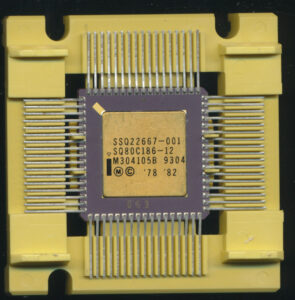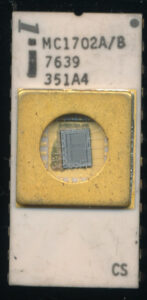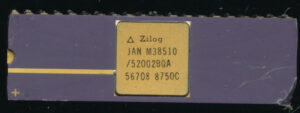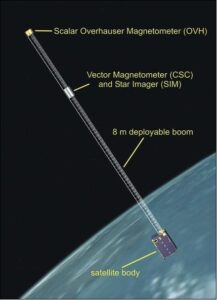SSQ22667-001: An 80C186 for the Space Station
Recently some interesting CPUs showed up on eBay and other IC selling sites. They were marked SSQ22667-001 and made by Intel. Some were conveniently also labeled SQ80C186-12. Packaged in a 68-pin CQFP package, they typically would be labeled as a MQ80C186 (Military CMOS 186 running at 12MHz) but these were as ‘SQ’ prefix, and had the weird SSQ22667-001 part # on them as well. Others in the same package were marked SSQ22668 and 22669. So what was special about these CPUs? Was this some random House # for an OEM? Nope, these were made for NASA, specifically to conform with MIL-STD-975. To learn a bit more about how these MIL-STD’s work, lets take a journey back to the 1960’s (everyone knows hat was a fun time)
Back in the 1960’s integrated circuits were getting to be more standard, and more available. Many companies were making many different types (generally simple logic at the time, but that was changing fast). The US Military was, of course, an early user of integrated circuits, as they could afford them, and IC’s allowed for some cutting edge technology. To make purchasing and stocking such components easier, the military, as they usually do, decided there needed to be some standards, and ICs for the military, should be available in higher standards
then those destined for your microwave oven or digital alarm clock. Thus in May of 1968 the MIL-STD-883 was released. This was (and continues to be, its on Rev L now) a standard created on Test methods and procedures for ICs, any IC’s. It provides such things as inspection methods, burn-in methods, lot sampling, and a whole host of other ways to test and inspect IC’s. As the years went by, different Classes of testing were added. A computer chip the captains coffee pot did not need the same testing as a computer chip destined for a nuclear submarine, or one for use in Space. Several classes were then created for space, S, V, Q and B, varying in the degree of testing needed. Obviously a vehicle designed to take people to space should use higher quality parts then one launching unmanned missions.
As IC’s continued to be developed, and many devices became ‘standard’ like various RTL/TTL devices and the like, the Military wanted to define those better for themselves as well. Thus in 1969 MIL-M-38510 was released. 38510, often called JAN38510 (Joint Army Navy Standard Naming which was used through Rev J in 1991) was a General Specification for Microcircuits. It provided fit, form and function standards for various devices. They could be made by anyone, anyway they liked, but to be marked/used as a JAN38510 device they had to meet what it defined that device to do. This was all
based on existing devices, it simply took a commercial device, such as a 74181 ALU, and gave it a 38510 description and part number. This ensured that no matter where the Military got that 38510 standard 74181 ALU it would behave the exact same. The 38510 standard refer’d back to the MIL-STD-883 testing procedures, it in itself did not define any testing.
As things progressed, MIL-STD-883 with the how, and MIL-M-38510 with the what, NASA decided they should have their own standard (American government agencies like to compete). Based on the 38510 standard,and the 883 testing standards NASA created MIL-STD-975 in 1976. This was essentially a list of products that met NASA’s standards for all electronic devices. Everything from capacitors, diodes, cables, oscillators and even some processors. Ultimately this was a great idea at the time. It provided designers with a list of parts they could use that NASA had already certified as acceptable, rather then having to test/certify every single piece. The cost and time saving were immense once the initial certification was done. The list of certified devices was updated every few years through 1994 when the standard was canceled, likely because there was just too much new devices becoming available to keep up with. Three levels of quality are used in this standard. Grade 1 parts arc very low risk, higher quality and
reliability parts intended for critical applications (such as man rated space applications). Grade 2 parts are low risk, high quality and reliability parts for usc in applications not requiring Grade 1 parts. Grade 3 parts are higher risk, good quality and reliability parts but are not recommended for applications requiring high product assurance levels.
These particular SQ80C186s are made by Intel and listed as Grade 3 devices. This is mainly because Intel decided not to take part in the NASA certification process, so their grading is based on their MIL-STD-883 QML (Qualified Manufacturer List) testing. These parts were used on many satellite designs (such as PoSAT-1, Portugal’s first satellite in 1993 and the 1999-2014 Danish Ørsted Geomagnetic Mission) as well as the International Space Station. Its possible on the ISS they were used in a non-mission critical area where Grade 3 is acceptable. Even as a Grade 3 device the replacement cost (in 2003) was $2,266. Today they are a mere collectors item, as parts like these need to have a certified traceability with them, knowing where they have been and how/where they were stored is important to them being certified for use. These particular chips were made in 1993, a lot can happen in 27 years of storage and transport around the world.
Posted in:
CPU of the Day





